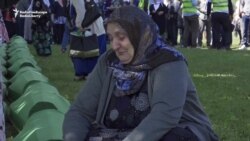POTOCARI, Bosnia-Herzegovina -- Thousands of people have gathered in Bosnia-Herzegovina to pay homage to the victims of the 1995 Srebrenica massacre, the worst mass killing in Europe since World War II.
Relatives of the more than 8,000 Bosnian Muslim men and boys rounded up and killed by Bosnian Serb forces in July 1995 were among those attending a ceremony at a memorial site near Srebrenica on July 11.
The ceremony, marking the 24th anniversary of the massacre, included the burial of 33 newly identified victims of the massacre, joining the 6,610 others who have already been identified and buried there.
A joint statement issued by European Union foreign-policy chief Federica Mogherini and Enlargement Commissioner Johannes Hahn described the "genocide" in Srebrenica as "one of the darkest moments of humanity in modern European history."
In a statement on July 11, the U.S. State Department said that "this painful chapter in European history must never be denied nor forgotten."
"We stand with those who continue to seek justice," it added. "We reaffirm our sustained support for those working to honor the dignity of all of the victims, including those who still await their final resting places."
A commemoration ceremony that was held in Sarajevo on July 9 was attended by international guests, including Turkish President Recep Tayyip Erdogan and Serbian Prime Minister Ana Brnabic.
The massacre is recognized as genocide by international courts, although Serbian and Bosnian Serb officials refuse to accept that wording.
Brnabic said on July 9 that Srebrenica was a "horrible crime."
Nine Serbian rights groups said in a statement on July 9 that it was "shameful" that no ruling Serbian official has ever called what happened in Srebrenica a genocide.
Thousands of people joined a peace march on July 8 through forests in Bosnia in memory of the massacre.
Every year forensic experts find more bodies in the nearly 100 mass graves located so far. The remains are identified through DNA analysis before they are buried again at a memorial center near Srebrenica, where the victims were last seen alive.
Here Are The Faces Of Thousands Who Died In Srebrenica
Srebrenica, located in eastern Bosnia, fell to Bosnian Serb forces on July 11, 1995.
Its Muslim population fled the town, which had been declared a UN "safe haven" for civilians. They rushed to the UN compound in hopes that the peacekeepers would protect them.
When forces led by Bosnian Serb General Ratko Mladic arrived at the UN compound, the Dutch peacekeepers quickly handed over the base. The Bosnian Serb forces then separated out men and boys for execution and sent the women and girls elsewhere in territory under their control.
Thousands of men and boys were executed. Those who tried to flee through the woods were hunted down and killed by Bosnian Serb forces.
Former Bosnian Serb political leader Radovan Karadzic was convicted in March 2016 of war crimes for his role while Mladic was sentenced in 2017 to life imprisonment after he, too, was found guilty of genocide and war crimes.
Correction: An earlier version of this story incorrectly stated that Bosnian Serb General Ratko Mladic was still on trial.












